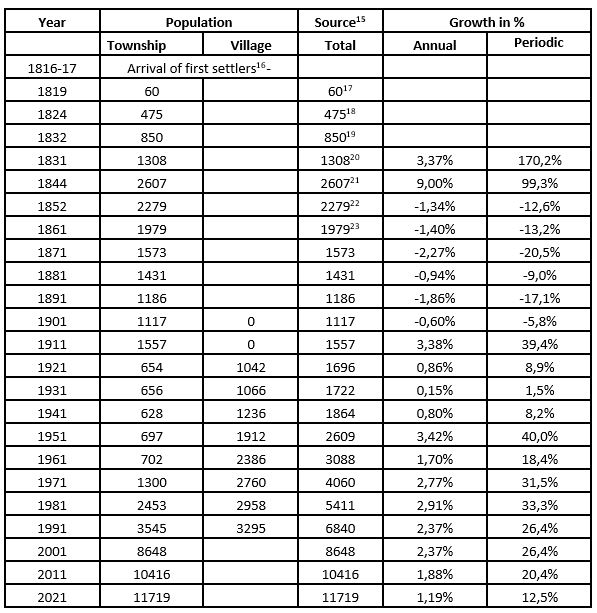From an uninhabited territory at the beginning of the 19e century, the population residing in the municipality of Rawdon at the 2021 census is approaching 12,000 persons. In order to appreciate the evolution of Rawdon since its creation, the following table shows its population according to various censuses carried out over time.
Census


From the beginning to the middle of the 19th century
The population of Rawdon grew very quickly during its first decades of existence. Since the arrival of the first settlers around 1816-1817, the population increased rapidly until it exceeded 2600 persons at the 1844 census. This growth did not go smoothly. It was not until more than 100 years later that Rawdon regained this initial population.
Various sources have documented these somewhat chaotic settlements in new regions. Normand Séguin[1] describes them as individual and spontaneous responses to the demographic surge and the offer of work. The population was ahead of the surveyors and the land was taken in a disorderly fashion, in the absence of any form of organization or civil authority. Marcel Fournier[2] mentions that several inhabitants of the St. Sulpice seigniory had settled in the first range of the Rawdon township. At the same time, the government had issued to several individuals Ticket of Location that were to be transformed into Letters Patent once the conditions of the Ticket of Location were fulfilled. Joseph Bouchette, in Appendix A of a report published in 1825[3], mentions some of these conflicts of occupation of the territory. Nancy Gadoury, in a thesis produced in 2004[4], reports that in 1824, Rawdon had 108 occupied lots. Of these, there were 30 squatters and 37 did not have their property titles. In fact, only 35 occupants had valid titles. Sixty-four of the 108 eventually obtained their Letters Patent. The initial territory of the Township of Rawdon consisted of a square of 10 mi. X 10 mi. with 11 ranges each containing 28 lots of 200 acres.
[1] Normand Séguin, La conquête du sol au 19e siècle
[2] Marcel Fournier Rawdon : 175 ans d'histoire, 1974
[3] Joseph Bouchette, General Report of an Official Tour through the New Settlements of the Province of Lower Canada, 1825
[4] Nancy Gadoury, L’encadrement du mouvement de colonisation dans le piedmont des Laurentides dans Lanaudière de 1810 à 1880, Université du Québec à Trois-Rivières, 2004
The years 1850-1900
During the following fifty years or so, Rawdon saw its population decrease to the point of reaching a low of about 1100 residents at the beginning of the 20e century. Two main factors would explain this decrease. On one hand, Rawdon was amputated of parts of its territory to allow the creation of neighbouring municipalities. The parish of Sainte-Julienne recognized by the church in 1848, the parish of Saint-Liguori created in 1852 and the township of Chertsey established in 1856 influenced the population census. On the other hand, according to some historians, several Irish families would have left the area disappointed by the low agricultural yields. Marcel Fournier is more precise and points out "Many young people were abandoning the land for the United States and settling in regions of rapid industrial progress such as Detroit, Wisconsin or Lake Superior. He adds "This regression was caused by several unavoidable factors: the impoverishment of the soil, (chemical fertilizers were ignored) the deforestation of the forests, (selective cutting was not practiced) and the scarcity of fauna (hunting was not reasonably practiced)".
The 20th century
From the beginning of the 20th century to this day, Rawdon has seen its population grow in an almost uninterrupted way, despite wars, economic recessions and other events. Economically justified for the export of forest products and, to a lesser extent, agricultural products, the construction of the railroad, with the arrival of the first passengers in Rawdon in August 1910, initiated the development of the tourist industry. The arrival of electricity in 1912 with the construction of the dam and the power station will help heighten this development. Many Montreal residents discovered the charms of Rawdon, practiced their favorite sports and eventually built a secondary residence. Many of them had emigrated from Russia and Poland. They were quickly followed by others from Eastern Europe. One of them,[1], in his autobiography, recognized that the Rawdon region resembled the Beskidy Mountains in Poland and found in Rawdon a second home. The presence of these different ethnic and linguistic communities has proven to be very enriching and gives a distinctive character to the municipality. The tourist industry has certainly influenced the occupation of the territory of Rawdon. Information from the January 2017 assessment roll of the Regional County Municipality of Matawinie highlights the importance of second homes and cottages for Rawdon. In fact, 542 of the 7153 residences (or 7.6%) were identified as secondary residences. The statistics available in the Schéma d'aménagement et de développement de la Municipalité Régionale de Comté de la Matawinie evaluated the seasonal population of Rawdon at 3,971 persons.
Administratively, it should be pointed out that, for most of the 20e century, the Village of Rawdon and the Township of Rawdon were under the jurisdiction of two distinct municipal administrations. A process of municipal amalgamation merged these two administrations and created the Municipality of Rawdon at the beginning of the 21e century pioneer families.
[1] Franciszek Moskal, The Passions of an Optimist, Arzed Edition, 2005
